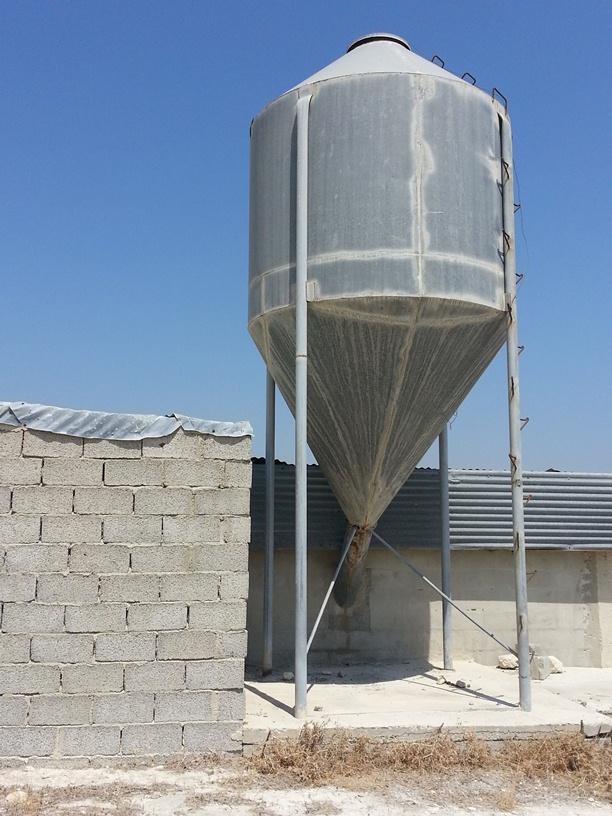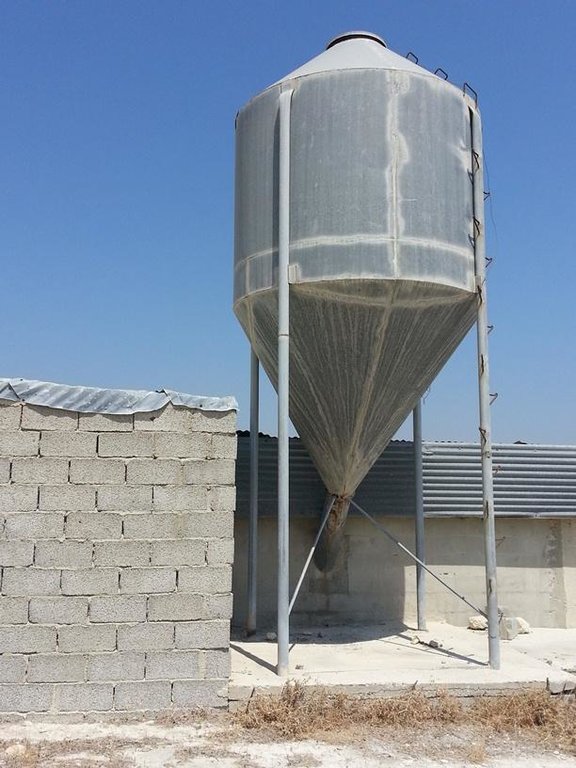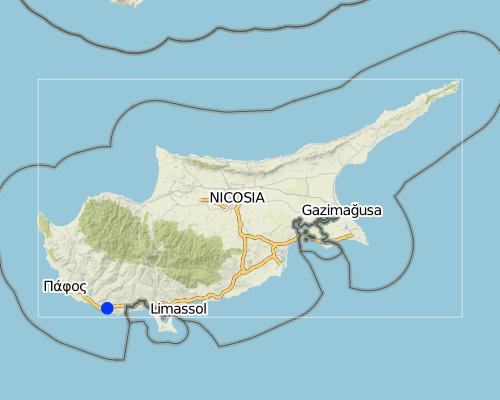Fodder provision to goats and sheep to reduce grazing pressure on natural vegetation [塞浦路斯]
- 创建:
- 更新:
- 编制者: Michalakis Christoforou
- 编辑者: –
- 审查者: Fabian Ottiger
Παροχή σιτηρεσίου στα αιγοπρόβατα ως εναλλακτική τροφή με σκοπό τη μείωση της υπερβόσκησης στα φυσικά οικοσυστήμα(greek)
technologies_1247 - 塞浦路斯
查看章节
全部展开 全部收起1. 一般信息
1.2 参与该技术评估和文件编制的资源人员和机构的联系方式
有助于对技术进行记录/评估的项目名称(如相关)
Catastrophic shifts in drylands (EU-CASCADE)有助于对技术进行记录/评估的机构名称(如相关)
Cyprus University of Technology (Cyprus University of Technology) - 塞浦路斯1.3 关于使用通过WOCAT记录的数据的条件
(现场)数据是什么时候汇编的?:
15/05/2014
编制者和关键资源人员接受有关使用通过WOCAT记录数据的条件。:
是
2. SLM技术的说明
2.1 技术简介
技术定义:
Use of different types of fodder in order to reduce grazing impact on natural vegetation
2.2 技术的详细说明
说明:
Goats graze on almost all plants even on thorny shrubs. The pastoralist in the past (some still do now a days) use to spread seeds on the grazing area in order to provide fodder for the animals. Another method is to provide fodder within the farm using dry seeds of wheat, barley, soya etc which can be stored in big silos.
Purpose of the Technology: The purpose of this technology is to provide to the animals with the food they need in order to minimize or even stop them from grazing on the wild flora such as shrubs, trees and annual plants. Within the study area, most of the vegetation is vanished and only traces of plant species can be found. Even the thorny shrubs like Callicotome villosa and Rhamnus oleiodes are suffering from overgrazing.
Establishment / maintenance activities and inputs: Fodder can be provided in-farm and out-farm. In-farm fodder is provided using a silo in which dry fodder can be store, mixed and deliver to the animals mechanically. Out-farm fodder is provided seasonally since the seeds should be seeded and plants must grow up before eaten by the animals
Natural / human environment: By providing fodder to the animals in-farm, grazing is avoided since the animals remain within the farm. This way, animal diseases transmission from one farm to another can be minimized. Also, animals may travel a long distance to find food whose energy miight be less than the energy they use.
Seeding on the hills will attract the goats and stop them from grazing on other wild plant species. Minimizing grazing will allow to the vegetation to recover and grow up providing good aesthetic view and also shelter for the wild animals. Furthermore, vegetation increase will contribute to the decrease of soil erosion and the increase of organic matter.
2.3 技术照片
2.5 已应用该技术的、本评估所涵盖的国家/地区/地点
国家:
塞浦路斯
区域/州/省:
Limassol
有关地点的进一步说明:
Pissouri
Map
×2.6 实施日期
如果不知道确切的年份,请说明大概的日期:
- 不到10年前(最近)
2.7 技术介绍
详细说明该技术是如何引入的:
- 通过土地使用者的创新
注释(项目类型等):
EU funding gave the opportunity to some new farmers to buy new equipment for fodder provision. In this way the new farmers were able to feed their animals and increase their productivity
3. SLM技术的分类
3.2 应用该技术的当前土地利用类型

牧场
粗放式放牧场:
- 半游牧/游牧
- 经营牧场
主要动物种类及产品:
Main species semi-nomadism: Goats/rabbits/birds
Main species ranching: Goats
注释:
Major land use problems (compiler’s opinion): overgrazing due to a large amount of animals, drought, erosion
Major land use problems (land users’ perception): drought, poor calcareous soils, incomes are not enough to buy food
Semi-nomadism / pastoralism: goats/ rabbits, birds
Ranching: goats
Future (final) land use (after implementation of SLM Technology): Cropland: Ca: Annual cropping
如果由于技术的实施而导致土地用途发生变化,则在技术实施前说明土地利的用途。:
Grazing land: Ge: Extensive grazing land
3.3 有关土地利用的更多信息
注释:
Water supply: rainfed, rainfed
每年的生长季节数:
- 2
具体说明:
Longest growing period in days: 120Longest growing period from month to month: March to JuneSecond longest growing period in days: 100Second longest growing period from month to month: September to December
牲畜密度(如相关):
> 100 LU /km2
3.4 该技术所属的SLM组
- 畜牧业和牧场管理
3.5 技术传播
具体说明该技术的分布:
- 均匀地分布在一个区域
如果该技术均匀地分布在一个区域上,请注明覆盖的大致区域。:
- 10-100 平方千米
注释:
The total area in which goat and sheep farmer are allowed to grow animals is around 400 Km2. The area affected by overgrazing is around 100Km2
3.6 包含该技术的可持续土地管理措施

农艺措施
- A1:植被和土壤覆盖层

结构措施
- S11:其它
注释:
Main measures: agronomic measures, structural measures
Specification of other structural measures: Use of Silos in order to provide fodder to the animals
Type of agronomic measures: mixed cropping / intercropping, legume inter-planting
3.7 该技术强调的主要土地退化类型

生物性退化
- Bc:植被覆盖的减少
注释:
Main type of degradation addressed: Bc: reduction of vegetation cover
Main causes of degradation: overgrazing (large number of animals), change in temperature (hot summers & cold winters force the animals to eat more in order to obtain water and energy from plants), change of seasonal rainfall (summers without rain and winters with some rain), droughts (heavy droughts every 3-4 years), poverty / wealth (farmers can not afford to feed the animals)
Secondary causes of degradation: deforestation / removal of natural vegetation (incl. forest fires) (about 90 years ago), urbanisation and infrastructure development (Urbanisation mostly at the coastal zone has forced the animals to move to the North. A large number of animals is concentrated in the northern site, increasing the overgrazing problem), inputs and infrastructure: (roads, markets, distribution of water points, other, …) (A highway road split the area in two), war and conflicts (In 1974 many refugees moved from the North to the South due to the invasion of Turkish troops. Most of them who established in the area became farmers, and therefore increased the number of animals)
3.8 防止、减少或恢复土地退化
具体数量名该技术与土地退化有关的目标:
- 减少土地退化
注释:
Main goals: mitigation / reduction of land degradation
4. 技术规范、实施活动、投入和成本
4.2 技术规范/技术图纸说明
Technical knowledge required for field staff / advisors: high (animal feeding specialist with good knowledge on goat and sheep fodder)
Technical knowledge required for land users: moderate (be able to follow the specialist advice and protocol for feeding animals)
Main technical functions: increase of biomass (quantity), promotion of vegetation species and varieties (quality, eg palatable fodder), control of animal feeding on natural vegetation
Mixed cropping / intercropping
Material/ species: cereal seeds (wheat, barley, etc)
Quantity/ density: 200kg/ha
Remarks: seeds should be seeded by hand during the rainy season
Legume inter-planting
Quantity/ density: 200kg/ha
Remarks: spread the seeds before the last rainfall in spring
Structural measure: Silo
Height of bunds/banks/others (m): 3
Width of bunds/banks/others (m): 1
Construction material (other): stainless steel
Specification of dams/ pans/ ponds: Capacity 9,42m3
4.3 有关投入和成本计算的一般信息
其它/国家货币(具体说明):
euro
注明美元与当地货币的汇率(如相关):1美元=:
0.77
注明雇用劳工的每日平均工资成本:
38.85
4.4 技术建立活动
| 活动 | 措施类型 | 时间 | |
|---|---|---|---|
| 1. | Buy or make a Silo | 结构性的 | anytime |
| 2. | Buy cereal seeds (200kg) | 农业学的 | |
| 3. | Buy legume seeds (200kg) | 农业学的 |
注释:
Inputs: Stainless steel
4.5 技术建立所需要的费用和投入
| 对投入进行具体说明 | 单位 | 数量 | 单位成本 | 每项投入的总成本 | 土地使用者承担的成本% | |
|---|---|---|---|---|---|---|
| 劳动力 | Labour | ha | 1.0 | 116.0 | 116.0 | 100.0 |
| 设备 | Stainless steel silo | ha | 1.0 | 2589.0 | 2589.0 | 100.0 |
| 设备 | Fodder transfer tubes | ha | 1.0 | 1000.0 | 1000.0 | 100.0 |
| 植物材料 | Agricultural | ha | 1.0 | 427.0 | 427.0 | 100.0 |
| 技术建立所需总成本 | 4132.0 | |||||
注释:
Duration of establishment phase: 0.5 month(s)
Life-span of cereal seeds: 6 months
Life-span of legumes seeds: 3-4 months
4.6 维护/经常性活动
| 活动 | 措施类型 | 时间/频率 | |
|---|---|---|---|
| 1. | spreading seeds | 农业学的 | during rainfall (oct - Mar) |
4.7 维护/经常性活动所需要的费用和投入(每年)
| 对投入进行具体说明 | 单位 | 数量 | 单位成本 | 每项投入的总成本 | 土地使用者承担的成本% | |
|---|---|---|---|---|---|---|
| 劳动力 | Labour | ha | 1.0 | 233.0 | 233.0 | 100.0 |
| 植物材料 | Seeds | ha | 1.0 | 427.0 | 427.0 | 100.0 |
| 技术维护所需总成本 | 660.0 | |||||
注释:
Cost were calculated according to the farmers opinion which was confirmed by the agricultural department. Seeds and labor are calculated as units per ha and the silo per unit (farm)
4.8 影响成本的最重要因素
描述影响成本的最决定性因素:
Cost for applying fodder is affected by 3 factors: a) the price of the Silo which is applied only once, b) the cost of the seeds and c) the labor needed for spreading the seeds. The slope in the area where the technology is applied is steep and makes the seeding difficult.
5. 自然和人文环境
5.1 气候
年降雨量
- < 250毫米
- 251-500毫米
- 501-750毫米
- 751-1,000毫米
- 1,001-1,500毫米
- 1,501-2,000毫米
- 2,001-3,000毫米
- 3,001-4,000毫米
- > 4,000毫米
有关降雨的规范/注释:
Annual rainfall for the year 2013 was 207 mm. From june to october rainfall was 0. In the last three years annual rainfall was between 207 and 540 mm
农业气候带
- 半干旱
- 干旱
Thermal climate class: tropics. Winter 0-25 °C, and Summer 20-45 °C
Thermal climate class: subtropics. During the winter, mean temperature can be 15-18 °C
According to the FAO, Cyprus is considered to be an arid to semi-arid area
5.2 地形
平均坡度:
- 水平(0-2%)
- 缓降(3-5%)
- 平缓(6-10%)
- 滚坡(11-15%)
- 崎岖(16-30%)
- 陡峭(31-60%)
- 非常陡峭(>60%)
地形:
- 高原/平原
- 山脊
- 山坡
- 山地斜坡
- 麓坡
- 谷底
垂直分布带:
- 0-100 m a.s.l.
- 101-500 m a.s.l.
- 501-1,000 m a.s.l.
- 1,001-1,500 m a.s.l.
- 1,501-2,000 m a.s.l.
- 2,001-2,500 m a.s.l.
- 2,501-3,000 m a.s.l.
- 3,001-4,000 m a.s.l.
- > 4,000 m a.s.l.
关于地形的注释和进一步规范:
Altitudinal zone: 100-500 m a.s.l (The area where the technology is applied is 1km far from the sea)
Landforms: Hill slopes (The area of interest consists of steep hill slopes)
Slopes on average are rolling (most common) and hilly (sometimes after soil erosion)
5.3 土壤
平均土层深度:
- 非常浅(0-20厘米)
- 浅(21-50厘米)
- 中等深度(51-80厘米)
- 深(81-120厘米)
- 非常深(> 120厘米)
土壤质地(表土):
- 粗粒/轻(砂质)
表土有机质:
- 中(1-3%)
如有可能,附上完整的土壤描述或具体说明可用的信息,例如土壤类型、土壤酸碱度、阳离子交换能力、氮、盐度等。:
Soil depth on average is very shallow (the area is considered to be rocky) to shallow (only where soil is concentrated)
Soil texture is coarse (Analysis has shown that soil texture is 50% sand, 25% silt and 25% Clay)
Soil fertility is low
Topsoil organic matter is medium where some vegetation is, low where no vegetation is and high where vegetation is
Soil drainage/infiltration is poor (inter patch), medium (patch-interpatch) or good (plant patch)
Soil water storage capacity is low-medium
5.4 水资源可用性和质量
地表水的可用性:
匮乏/没有
关于水质和水量的注释和进一步规范:
Availability of surface water is poor/none (there is no surface water available in the area)
5.5 生物多样性
物种多样性:
- 低
关于生物多样性的注释和进一步规范:
Thorny shrubs, olive and carob trees, annual grass
5.6 应用该技术的土地使用者的特征
非农收入:
- 收入的10-50%
相对财富水平:
- 贫瘠
- 平均水平
个人或集体:
- 个人/家庭
性别:
- 女人
- 男人
说明土地使用者的其他有关特征:
Land users applying the Technology are mainly Leaders / privileged
Difference in the involvement of women and men: no young women are involved with goat farming
Population density: 10-50 persons/km2
Annual population growth: negative
10% of the land users are average wealthy and own 10% of the land (they make profit).
10% of the land users are poor and own 5% of the land (they barely survive).
Off-farm income specification: Some of the pastoralists who apply the SLM technology, have apartments which they rent to tourists during the summer season
Market orientation of production system: Equipment and structure subsidy (50% of the equipment and structures are funded)
Market orientation: Mixed (subsistence and commercial): Pastoralists receive subsidy from EU funds annually
5.7 应用该技术的土地使用者拥有或租用的平均土地面积
- < 0.5 公顷
- 0.5-1 公顷
- 1-2 公顷
- 2-5公顷
- 5-15公顷
- 15-50公顷
- 50-100公顷
- 100-500公顷
- 500-1,000公顷
- 1,000-10,000公顷
- > 10,000公顷
这被认为是小规模、中规模还是大规模的(参照当地实际情况)?:
- 大规模的
注释:
The animal numbers are 10 times the amount permitted to graze in the area
5.8 土地所有权、土地使用权和水使用权
土地所有权:
- 州
土地使用权:
- 自由进入(无组织)
- 个人
注释:
More than 70% of the land belongs to the government (forestry department) and the land is open to everybody. The pastoralists do not pay rent for using the land. The land which belongs to individuals is used by the owners or is been rented to the pastoralists
5.9 进入服务和基础设施的通道
健康:
- 贫瘠
- 适度的
- 好
教育:
- 贫瘠
- 适度的
- 好
技术援助:
- 贫瘠
- 适度的
- 好
就业(例如非农):
- 贫瘠
- 适度的
- 好
市场:
- 贫瘠
- 适度的
- 好
能源:
- 贫瘠
- 适度的
- 好
道路和交通:
- 贫瘠
- 适度的
- 好
饮用水和卫生设施:
- 贫瘠
- 适度的
- 好
金融服务:
- 贫瘠
- 适度的
- 好
6. 影响和结论性说明
6.1 该技术的现场影响
社会经济效应
生产
饲料生产
注释/具体说明:
Spreading cereals and legumes
畜牧生产
注释/具体说明:
By providing fodder all year round
生产故障风险
注释/具体说明:
By providing fodder all year round
产品多样性
注释/具体说明:
Better quality of dairy products
土地管理
收入和成本
农业投入费用
注释/具体说明:
During the first year, the cost of the Silo
农业收入
注释/具体说明:
Due to production increase
工作量
注释/具体说明:
In-farm fodder provision. Labor hours are reduced due to the presence of fodder in the silo. Simplified farm operations through using the silo.
社会文化影响
食品安全/自给自足
注释/具体说明:
Animals from different farms are no more in contact
SLM/土地退化知识
注释/具体说明:
Seeding on the hill reduces erosion
冲突缓解
注释/具体说明:
Between pastoralists
Improved livelihoods and human well-being
注释/具体说明:
Shepherds who provide fodder and/or are seeding cereals and legumes on grazing land, produce more milk and meat. Therefore, they have higher incomes and a better life. They are able to send their children to school and provide a health care insurance to their families.
生态影响
水循环/径流
地表径流
注释/具体说明:
Due to vegetation cover
蒸发
注释/具体说明:
Due to vegetation cover
土壤
土壤水分
注释/具体说明:
Due to vegetation cover
土壤覆盖层
土壤流失
注释/具体说明:
Due to soil cover by cereals and legumes
生物多样性:植被、动物
植物多样性
注释/具体说明:
May be in the near future, antagonism between cereals and legumes with other wild type species will appear
动物多样性
注释/具体说明:
Especially birds
6.2 该技术的场外影响已经显现
对邻近农田的破坏
注释/具体说明:
On site since the animals will graze in the seeded area
对公共/私人基础设施的破坏
注释/具体说明:
On site since the animals will graze in the seeded area
6.3 技术对渐变气候以及与气候相关的极端情况/灾害的暴露和敏感性(土地使用者认为的极端情况/灾害)
渐变气候
渐变气候
| 季节 | 气候变化/极端天气的类型 | 该技术是如何应对的? | |
|---|---|---|---|
| 年温度 | 增加 | 不好 |
气候有关的极端情况(灾害)
气象灾害
| 该技术是如何应对的? | |
|---|---|
| 局地暴雨 | 好 |
| 局地风暴 | 未知 |
气候灾害
| 该技术是如何应对的? | |
|---|---|
| 干旱 | 不好 |
水文灾害
| 该技术是如何应对的? | |
|---|---|
| 比较和缓的(河道)洪水 | 未知 |
其他气候相关的后果
其他气候相关的后果
| 该技术是如何应对的? | |
|---|---|
| 缩短生长期 | 未知 |
6.4 成本效益分析
技术收益与技术建立成本相比如何(从土地使用者的角度看)?
短期回报:
非常消极
长期回报:
稍微积极
技术收益与技术维护成本/经常性成本相比如何(从土地使用者的角度看)?
短期回报:
中性/平衡
长期回报:
稍微积极
注释:
Shepherds who apply the technology and are in a better socio-economical status are satisfied with their incomes but they believe that things could get better. Shepherds who don't apply the technology are poor, not satisfied with the incomes they receive and at the same time they are negative in applying the technology although they see other shepherds being in a better socio-economic status than them.
6.5 技术采用
注释:
100% of land user families have adopted the Technology with external material support
2 land user families have adopted the Technology with external material support
Comments on acceptance with external material support: New farmers-shepherds can have up to 60% funding from EU and government funds for construction and equipment
There is no trend towards spontaneous adoption of the Technology
Comments on adoption trend: The cost of buying fodder is extremely high. Also the equipments (silo) is considered to be expensive.
6.7 该技术的优点/长处/机会
| 土地使用者眼中的长处/优势/机会 |
|---|
| Using the Silo for providing fodder, they spend less hours in the farm. |
| By providing fodder, the quality and quantity of milk and meat is better |
| By keeping the animals in the farm, they save work hours and also the threat of animal poisoning is minimized |
| 编制者或其他关键资源人员认为的长处/优势/机会 |
|---|
|
By providing fodder in and out of the farm the animals receive a better quality of fodder and the right quantities of fodder they need. How can they be sustained / enhanced? experts can give advices to the shepherds about the type of fodder, and the quantity during different seasons |
|
Through grazing in a specific area marked and seeded by the shepherd, the animals avoid direct contact with other animals. This minimizes the spread of diseases between animals of different farms. How can they be sustained / enhanced? Shepherds should come to an agreement about the area their animals graze and create borders |
|
Seeding cereals and legumes within the grazing areas decreases overgrazing on shrubs and annual plants How can they be sustained / enhanced? in the case where the shepherd is leading the animals, he should not allow the animals to graze on shrubs |
|
The presence of a Silo in a farm makes fodder provision easier and therefore less work is required How can they be sustained / enhanced? Government funding can cover the cost of the silo |
| seeding in the grazing area leads to improved soil cover which minimizes soil erosion |
6.8 技术的弱点/缺点/风险及其克服方法
| 土地使用者认为的弱点/缺点/风险 | 如何克服它们? |
|---|---|
| It is difficult to spread seeds on the rocky hills | |
| Buying fodder is expensive |
| 编制者或其他关键资源人员认为的弱点/缺点/风险 | 如何克服它们? |
|---|---|
| Not all shepherd are able to buy the Silo and large amounts of fodder to store in the silo | Government funding can cover the cost of the silo |
| The Randi forest area is suffering from prolonged droughts. Seeding cereals in the grazing land will not be achieved without rain. |
链接和模块
全部展开 全部收起链接
无链接
模块
无模块




